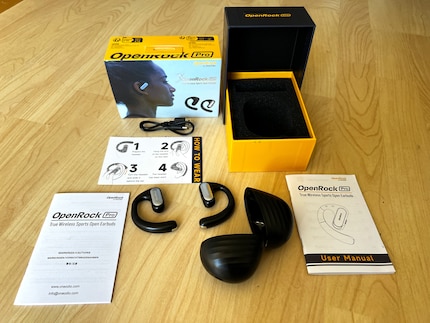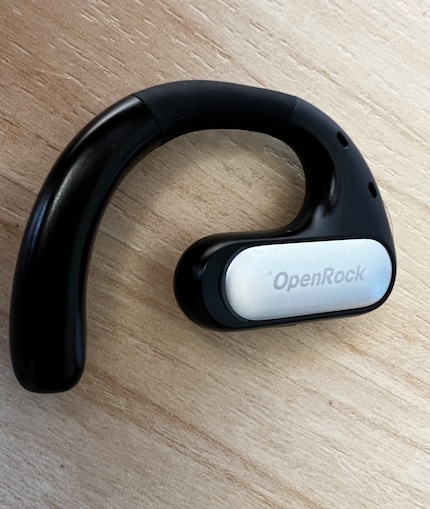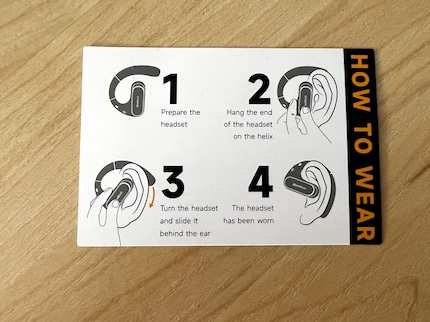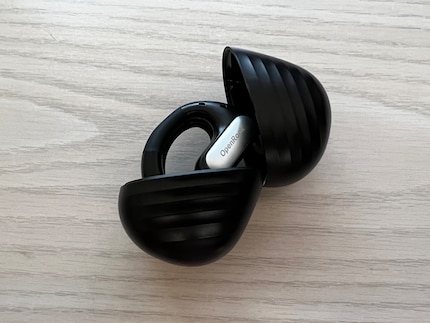
Product test
Trying to fall into a deep sleep, but someone’s snoring? These Soundcore Sleep A30 earbuds can make it happen
by Siri Schubert

The OpenRock Pro seemed like a niche product to me with no real use case. I was wrong. But the majority of people still won’t buy these earphones.
The OpenRock Pro are sports headphones with an open design. The advantage of this design is that you can hear your surroundings even while listening to music. In addition, the speaker is located in front of the ear and doesn’t have to be inserted into the ear canal, which should improve wearing comfort.
«What in the world...?» I think to myself as I unpack OpenRock Pro by OneOdio. I’m greeted by an almost fist-sized plastic charging case – oval, just under ten centimetres tall and weighing a whopping 90 grammes with both earpieces in. It creates quite the bulge in your pocket.
It takes me a second to figure out how to open the case. It snaps open vertically. But the surprises don’t end there; the huge, partially rubberised, rounded headphones frankly don’t look like they belong on your ears. The way they’re shaped, a completely different orifice comes to mind for inserting the OpenRock Pro.
The massive case is meant to store the rather large earphones in a reasonably space-saving way and, of course, to charge them. Despite the somewhat slapdash hinge, the case feels stable. You probably wouldn’t have to worry about your Openrock Pro headphones breaking if you drop the case. There are no bells and whistles that could break; just a USB-C port for charging and a button for pairing.
I find the OpenRock Pro really comfortable. Tipping the scales at 13 grammes per earpiece, they’re much lighter than they look. That’s also why they stay put on my ear better than I’d feared. To get an even closer fit, you can bend the rubberised part of the headband. As for the aesthetics of the OpenRock Pro, they take some getting used to. But there’s no accounting for taste.
The headphones each contain a 16.2 mm driver and the so-called TubeBass Technology. With it, OneOdio promises that the headphones offer more bass and more powerful sound than competing devices. Mind you, that’s not saying much, as open design on-ear headphones are rare.
I can hear that the headphones are at their core designed to be worn during physical activities – for so-called pumping music, or music meant to pump you up. Correspondingly, the lows on Cosmic Order, an electronic, very bass-heavy song, are dominant and powerful. The mids are quite soft. They don’t sound bad, but often lose the battle against the bass. This is somewhat to the detriment of the vocals.
On the other hand, the trebles are clearly more audible. This is particularly evident in Tchaikovsky’s Piano Concerto, where high-frequency sounds are reproduced clearly and without distortion. I don’t hear any distortion or cracking. Now, we’re not talking about the same brilliance as you get from Sony’s WF-1000 XM5 or Sennheiser’s Momentum 4 TW. But for earphones in this price range, the OpenRock Pro perform well. I’d rank them as upper mid-range.
The sound isn’t bad. But which use cases is the OpenRock Pro’s special design meant for? They can be great if, for example, you find in-ears uncomfortable but don’t want to carry around bulky over-ears either. Or if you want to remain aware of your environment when listening to music, such as when jogging or cycling.
The problem here is the volume. At home on my couch, it’s enough. But if I use the headphones in a louder environment, I have trouble hearing the music because of natural soundscapes like wind as well as other ambient noises like engines. Even turning up the sound to full blast isn’t enough. At least the headphones do stay put when running to catch the bus.
My concerns of sound bleed proved unnecessary. Sound bleed refers to when those around you can hear the sound coming out of your headphones. I had a friend sit next to me on the bus. Only when he held his head very close to mine (less than 50 centimetres away) could he listen in. Good thing, too, as no one will be forced to enjoy my fave rendition of Itsy Bitsy Spider...
The microphone is the weak point of the OpenRock Pro. I can’t recommend them as a lightweight headset replacement. When talking on the phone, the person on the other end complains that I’m very quiet. I’m also not particularly audible in audio recordings, like in WhatsApp voice messages. But judge that for yourself:
During testing, I got a battery life of nearly 46 hours. Impressive! The earpieces last 17 hours on a charge, and the charging case offers about two more charging cycles. That’s enough to last me a full work week, even with intensive use.
Furthermore, the OpenRock Pro are equipped with a fast-charging function. Five minutes of charging give me 60 minutes of playback time. Charging them for 15 minutes in the morning during breakfast is enough to get me through the day. The earpieces also shine with their energy-saving features. They turn off automatically after ten minutes of inactivity.
The OpenRock Pro from OneOdio sound good, albeit a bit bass-heavy. The unusual form factor proves very convenient. And the battery even outshines the top competition from Sony.
What I don’t like is the microphone, which makes it almost impossible to understand me. Furthermore, the OpenRock Pro’s volume quickly reaches its limits in loud surroundings. But if you’re looking for a lightweight alternative to in-ears for the gym, as a sleep aid, or for jogging in a quiet neighbourhood, I say go for it!
Header image: Florian BodokyI've been tinkering with digital networks ever since I found out how to activate both telephone channels on the ISDN card for greater bandwidth. As for the analogue variety, I've been doing that since I learned to talk. Though Winterthur is my adoptive home city, my heart still bleeds red and blue.

Product test
by Siri Schubert

Product test
by Florian Bodoky

Product test
by Florian Bodoky


In all my time testing headphones, this is the first time I have to look at the instructions. Why? Because I really can’t wrap my head around how these devices are supposed to attach to my ears. Here’s how: the speaker is located in front of your ear canal. No part of the earphones goes into your ear. This is comfortable and convenient – unless you wear wide frame glasses. Because the headphones go behind and then above your ear, they can get in the way and be annoying.

With their IPX5 rating, they’re also protected from light rain. The user interface is interesting. It’s pleasant, but at times somewhat unorthodox; each earpiece has a physical button – the manufacturer has opted to stay away from touch controls. With a quick press of the button, you can play and pause your music. A double tap, on the other hand, increases the volume on the right side and decreases it on the left side. Pressing and holding for a second and a half skips to the next track. It’s unusual, but not unpleasant.
To judge the performance, I listen to three songs of different genres, plus a podcast: Baker Street by Gerry Rafferty, The Seasons, Op. 37a: August by Tchaikovsky, and Cosmic Order by Avao. The sound is definitely punchy and the bass delivers strong results with plenty of boom, but it doesn’t compare to the bass of in-ear or over-ear headphones. After all, due to the open design, even if the speaker is placed directly in front of your ear, there’s always some loss when the waves are transmitted. This doesn’t happen when the earpiece is placed directly inside your ear canal or if it goes over your entire ear. In addition, in- and over-ear models benefit from noise cancellation – something that the OpenRock Pro don’t have.

Inspired by colleague Kevin Hofer’s mission to find suitable headphones to sleep with, I also test the OpenRock Pro in bed and am positively surprised. Unlike with in-ears, there’s nothing drilling into my ears when I sleep on my side. Thanks to the rubber coating, the pressure at the top of my ear where the frame rests against my head isn’t bad either. Last but not least, unlike ordinary in-ears, the OpenRock Pro don’t fall out, and I don’t have to search for them under my armada of pillows the next morning. I award extra points for that.